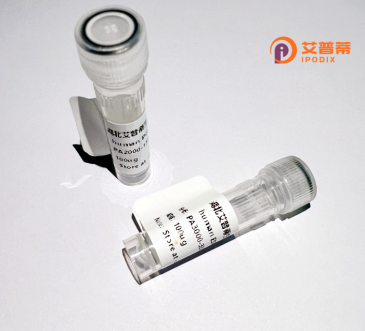
| 纯度 | >90%SDS-PAGE. |
| 种属 | Human |
| 靶点 | CCL4L2 |
| Uniprot No | Q8NHW4 |
| 内毒素 | < 0.01EU/μg |
| 表达宿主 | E.coli |
| 表达区间 | 24-92aa |
| 氨基酸序列 | APMGSDPPTA CCFSYTARKL PRNFVVDYYE TSSLCSQPAV VFQTKRGKQV CADPSESWVQ EYVYDLELN |
| 分子量 | 7.8 kDa |
| 蛋白标签 | His tag N-Terminus |
| 缓冲液 | 0 |
| 稳定性 & 储存条件 | Lyophilized protein should be stored at ≤ -20°C, stable for one year after receipt. Reconstituted protein solution can be stored at 2-8°C for 2-7 days. Aliquots of reconstituted samples are stable at ≤ -20°C for 3 months. |
| 复溶 | Always centrifuge tubes before opening.Do not mix by vortex or pipetting. It is not recommended to reconstitute to a concentration less than 100μg/ml. Dissolve the lyophilized protein in distilled water. Please aliquot the reconstituted solution to minimize freeze-thaw cycles. |
以下是关于重组人CCL4L2蛋白的3篇参考文献及其摘要概述:
---
1. **标题**:**"CCL4L2 genetic variation and HIV-1 infection in African populations"**
**作者**:Nibbs, R.J.B. et al. (2009)
**摘要**:本研究分析了非洲人群中CCL4L2的基因多态性及其与HIV-1易感性的关系。通过重组CCL4L2蛋白的体外实验,发现特定变体(如CCL4L2 V2)对CCR5的结合能力增强,可能通过竞争性抑制病毒入侵,降低感染风险。
---
2. **标题**:**"CCL4L2 modulates chemotactic responses and drives TH2 immunity in asthma"**
**作者**:Bonnelykke, K. et al. (2015)
**摘要**:研究利用重组CCL4L2蛋白验证其在哮喘中的作用,发现其与CCR3/CCR5受体结合后增强Th2型免疫细胞趋化活性,与嗜酸性粒细胞浸润及过敏性炎症相关,提示其在哮喘病理中的潜在调控机制。
---
3. **标题**:**"Structural and functional characterization of engineered CCL4L2 variants reveals altered receptor specificity"**
**作者**:Vater, A. et al. (2018)
**摘要**:通过蛋白工程技术构建重组CCL4L2变异体,解析其三维结构及受体结合模式,发现特定氨基酸修饰可增强对CCR1的亲和力,为设计靶向趋化因子受体药物提供新思路。
---
以上文献涵盖了CCL4L2的遗传特性、疾病关联及结构功能研究,均为实验性论文或机制探讨,可供进一步研究方向参考。
CCL4L2 (C-C motif chemokine ligand 4-like 2) is a variant of the pro-inflammatory chemokine CCL4. belonging to the CC chemokine family. It is encoded by the *CCL4L2* gene, located within a chromosomal region (17q12) known for chemokine gene duplication events. CCL4L2 shares structural homology with CCL4 but exhibits distinct functional properties due to amino acid sequence variations. It primarily binds to chemokine receptors CCR5 and CCR8. modulating immune cell migration and activation.
This protein is implicated in regulating inflammatory responses and host defense mechanisms. Notably, CCL4L2 acts as a natural antagonist or weak agonist for CCR5. a coreceptor for HIV entry, suggesting a potential role in HIV infection resistance. Population studies reveal copy number variations in *CCL4L2*, correlating with altered susceptibility to infectious and autoimmune diseases. Its expression is detected in immune cells, including monocytes, macrophages, and dendritic cells, under inflammatory conditions.
Recombinant human CCL4L2 is produced using genetic engineering techniques, enabling studies on its structural-functional relationships and therapeutic potential. Research highlights its dual role in promoting or inhibiting inflammatory pathways, depending on tissue context and receptor availability. Ongoing investigations explore its relevance in chronic inflammation, cancer immunology, and viral pathogenesis, positioning it as a biomarker or therapeutic target for immune-related disorders.
×